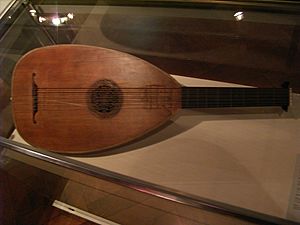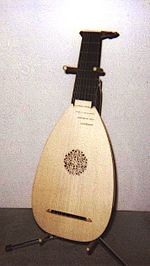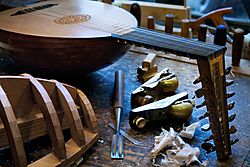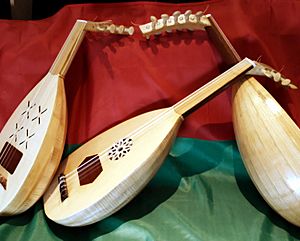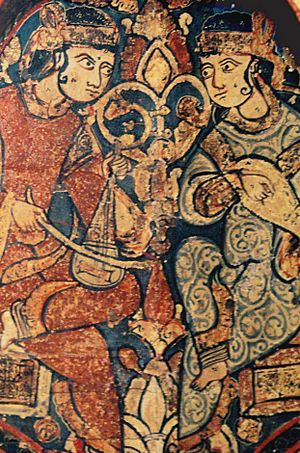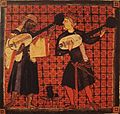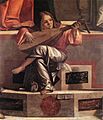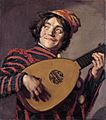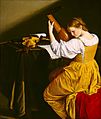Lute facts for kids
The lute is a kind of musical instrument with strings.
The first lutes were brought to Spain by the Moors. Others may have been brought to Europe from Arabic lands. The lute is one of the ancestors of the classical guitar.
A lute has an oval-shaped back, made of strips of wood. It has a flat front, with a neck attached to it. Early lutes had four strings or eight sets of two strings. Beneath these strings, there were strings tied to the neck, where the player pressed down to make the notes. These strings were called frets.
The front part of the body is made of a flat piece of wood, and known as the sound board. It has a beautifully carved hole in the center which is called the rose.
The lute was at first played by strumming or plucking with a pick. Later they were played with the fingers alone.
During the Renaissance, bigger lutes were designed. Most lutes at this time had seven or eight sets of strings. New kinds of lutes were invented. One new kind of lute made in the Renaissance was the theorbo. Another kind was the archlute.
In European classical music the lute was changed into the harpsichord and the mandolin.
Today there are kinds of lute still being played in Greece, Turkey, and in Arabic-speaking countries. The Renaissance lute is also played today, in western countries, as well as a German lute that is played the same way as a guitar.
Contents
Construction
Soundboard
Lutes are made almost entirely of wood. The soundboard is a teardrop-shaped thin flat plate of resonant wood (typically spruce). In all lutes the soundboard has a single (sometimes triple) decorated sound hole under the strings called the rose. The sound hole is not open, but rather covered with a grille in the form of an intertwining vine or a decorative knot, carved directly out of the wood of the soundboard.
The geometry of the lute soundboard is relatively complex, involving a system of barring that places braces perpendicular to the strings at specific lengths along the overall length of the belly, the ends of which are angled to abut the ribs on either side for structural reasons. Robert Lundberg, in his book Historical Lute Construction, suggests ancient builders placed bars according to whole-number ratios of the scale length and belly length. He further suggests the inward bend of the soundboard (the "belly scoop") is a deliberate adaptation by ancient builders to afford the lutenist's right hand more space between the strings and soundboard.
Soundboard thickness varies, but generally hovers between 1.5 and 2 mm (0.06–0.08 in). Some luthiers tune the belly as they build, removing mass and adapting bracing to produce desirable sonic results. The lute belly is almost never finished, but in some cases the luthier may size the top with a very thin coat of shellac or glair to help keep it clean. The belly joins directly to the rib, without a lining glued to the sides, and a cap and counter cap are glued to the inside and outside of the bottom end of the bowl to provide rigidity and increased gluing surface.
After joining the top to the sides, a half-binding is usually installed around the edge of the soundboard. The half-binding is approximately half the thickness of the soundboard and is usually made of a contrasting color wood. The rebate for the half-binding must be extremely precise to avoid compromising structural integrity.
Back
The back or the shell is assembled from thin strips of hardwood (maple, cherry, ebony, rosewood, gran, wood and/or other tonewoods) called ribs, joined (with glue) edge to edge to form a deep rounded body for the instrument. There are braces inside on the soundboard to give it strength.
Neck
The neck is made of light wood, with a veneer of hardwood (usually ebony) to provide durability for the fretboard beneath the strings. Unlike most modern stringed instruments, the lute's fretboard is mounted flush with the top. The pegbox for lutes before the Baroque era was angled back from the neck at almost 90° (see image), presumably to help hold the low-tension strings firmly against the nut which, traditionally, is not glued in place but is held in place by string pressure only. The tuning pegs are simple pegs of hardwood, somewhat tapered, that are held in place by friction in holes drilled through the pegbox.
As with other instruments that use friction pegs, the wood for the pegs is crucial. As the wood suffers dimensional changes through age and loss of humidity, it must retain a reasonably circular cross-section to function properly—as there are no gears or other mechanical aids for tuning the instrument. Often pegs were made from suitable fruitwoods such as European pearwood, or equally dimensionally stable analogues. Matheson, c. 1720, said, "If a lute-player has lived eighty years, he has surely spent sixty years tuning."
Bridge
The bridge, sometimes made of a fruitwood, is attached to the soundboard typically between a fifth and a seventh of the belly length. It does not have a separate saddle but has holes bored into it to which the strings attach directly. The bridge is made so that it tapers in height and length, with the small end holding the trebles and the higher and wider end carrying the basses. Bridges are often colored black with carbon black in a binder, often shellac and often have inscribed decoration. The scrolls or other decoration on the ends of lute bridges are integral to the bridge, and are not added afterwards as on some Renaissance guitars (cf Joachim Tielke's guitars).
Frets
The frets are made of loops of gut tied around the neck. They fray with use, and must be replaced from time to time. A few additional partial frets of wood are usually glued to the body of the instrument, to allow stopping the highest-pitched courses up to a full octave higher than the open string, though these are considered anachronistic by some (though John Dowland and Thomas Robinson describe the practice of gluing wooden frets onto the soundboard). Given the choice between nylon and gut, many luthiers prefer to use gut, as it conforms more readily to the sharp angle at the edge of the fingerboard.
Strings
Strings were historically made of animal gut, usually from the small intestine of sheep (sometimes in combination with metal) and are still made of gut or a synthetic substitute, with metal windings on the lower-pitched strings. Modern manufacturers make both gut and nylon strings, and both are in common use. Gut is more authentic for playing period pieces, though unfortunately it is also more susceptible to irregularity and pitch instability due to changes in humidity. Nylon offers greater tuning stability, but is seen as anachronistic by purists, as its timbre differs from the sound of earlier gut strings. Such concerns are moot when more recent compositions for the lute are performed.
Of note are the catlines used as basses on historical instruments. Catlines are several gut strings wound together and soaked in heavy metal solutions to increase the string mass. Catlines can be quite large in diameter compared to wound nylon strings of the same pitch. They produce a bass that differs somewhat in timbre from nylon basses.
The lute's strings are arranged in courses, of two strings each, though the highest-pitched course usually consists of only a single string, called the chanterelle. In later Baroque lutes two upper courses are single. The courses are numbered sequentially, counting from the highest pitched, so that the chanterelle is the first course, the next pair of strings is the second course, etc. Thus an 8-course Renaissance lute usually has 15 strings, and a 13-course Baroque lute has 24.
The courses are tuned in unison for high and intermediate pitches, but for lower pitches one of the two strings is tuned an octave higher (the course where this split starts changed over the history of the lute). The two strings of a course are virtually always stopped and plucked together, as if a single string—but in rare cases, a piece requires that the two strings of a course be stopped or plucked separately. The tuning of a lute is a complicated issue, described in a section of its own below. The lute's design makes it extremely light for its size.
History and evolution of the lute
First lutes
The origins of the lute are obscure, and organologists disagree about the very definition of a lute. The highly influential organologist Curt Sachs distinguished between the "long-necked lute" (Langhalslaute) and the short-necked variety: both referred to chordophones with a neck as distinguished from harps and psalteries. Smith and others argue the long-necked variety should not be called lute at all because it existed for at least a millennium before the appearance of the short-necked instrument that eventually evolved into what is now known as the lute. The long-necked variety also was never called a lute before the twentieth century.
Musicologist Richard Dumbrill today uses the word to discuss instruments that existed millennia before the term "lute" was coined. Dumbrill documented more than 3000 years of iconographic evidence for the lutes in Mesopotamia, in his book The Archaeomusicology of the Ancient Near East. According to Dumbrill, the lute family included instruments in Mesopotamia prior to 3000 BC. He points to a cylinder seal as evidence; dating from c. 3100 BC or earlier (now in the possession of the British Museum) the seal depicts on one side what is thought to be a woman playing a stick "lute". Like Sachs, Dumbrill saw length as distinguishing lutes, dividing the Mesopotamian lutes into a long variety and a short. His book does not cover the shorter instruments that became the European lute, beyond showing examples of shorter lutes in the ancient world. He focuses on the longer lutes of Mesopotamia, various types of necked chordophones that developed throughout ancient world: Greek, Egyptian (in the Middle Kingdom), Iranian (Elamite and others), Hittite, Roman, Bulgar, Turkic, Indian, Chinese, Armenian/Cilician cultures. He names among the long lutes, the pandura and the tanbur
The line of short lutes was further developed to the east of Mesopotamia, in Bactria and Gandhara, into a short, almond-shaped lute.
Persian barbat, Arab oud
Bactria and Gandhara became part of the Sasanian Empire (224–651). Under the Sasanians, a short almond shaped lute from Bactria came to be called the barbat or barbud, which was developed into the later Islamic world's oud or ud. When the Moors conquered Andalusia in 711, they brought their ud along, into a country that had already known a lute tradition under the Romans, the pandura.
During the 8th and 9th centuries, many musicians and artists from across the Islamic world flocked to Iberia. Among them was Abu l-Hasan ‘Ali Ibn Nafi‘ (789–857), a prominent musician who had trained under Ishaq al-Mawsili (d. 850) in Baghdad and was exiled to Andalusia before 833 AD. He taught and has been credited with adding a fifth string to his oud and with establishing one of the first schools of music in Córdoba.
By the 11th century, Muslim Iberia had become a center for the manufacture of instruments. These goods spread gradually to Provence, influencing French troubadours and trouvères and eventually reaching the rest of Europe. While Europe developed the lute, the oud remained a central part of Arab music, and broader Ottoman music as well, undergoing a range of transformations.
Although the major entry of the short lute was in western Europe, leading to a variety of lute styles, the short lute entered Europe in the East as well; as early as the sixth century, the Bulgars brought the short-necked variety of the instrument called Komuz to the Balkans.
From Middle Ages to Baroque
Beside the introduction of the lute to Spain (Andalusia) by the Moors, another important point of transfer of the lute from Arabian to European culture was Sicily, where it was brought either by Byzantine or later by Muslim musicians. There were singer-lutenists at the court in Palermo following the Norman conquest of the island from the Muslims, and the lute is depicted extensively in the ceiling paintings in the Palermo’s royal Cappella Palatina, dedicated by the Norman King Roger II of Sicily in 1140. His Hohenstaufen grandson Frederick II, Holy Roman Emperor (1194–1250) continued integrating Muslims into his court, including Moorish musicians. By the fourteenth century, lutes had disseminated throughout Italy and, probably because of the cultural influence of the Hohenstaufen kings and emperor, based in Palermo, the lute had also made significant inroads into the German-speaking lands.
Medieval lutes were 4- or 5-course instruments, plucked using a quill as a plectrum. There were several sizes, and by the end of the Renaissance, seven different sizes (up to the great octave bass) are documented. Song accompaniment was probably the lute's primary function in the Middle Ages, but very little music securely attributable to the lute survives from the era before 1500. Medieval and early-Renaissance song accompaniments were probably mostly improvised, hence the lack of written records.
In the last few decades of the fifteenth century, to play Renaissance polyphony on a single instrument, lutenists gradually abandoned the quill in favor of plucking the instrument with the fingertips. The number of courses grew to six and beyond. The lute was the premier solo instrument of the sixteenth century, but continued to accompany singers as well.
In about the year 1500 many Iberian lutenists adopted vihuela de mano, a viol-shaped instrument tuned like the lute, but both instruments continued in coexistence. This instrument also found its way to parts of Italy that were under Spanish domination (especially Sicily and the papal states under the Borgia pope Alexander VI who brought many Catalan musicians to Italy), where it was known as the viola da mano.
By the end of the Renaissance the number of courses had grown to ten, and during the Baroque era the number continued to grow until it reached 14 (and occasionally as many as 19). These instruments, with up to 26–35 strings, required innovations in the structure of the lute. At the end of the lute's evolution the archlute, theorbo and torban had long extensions attached to the main tuning head to provide a greater resonating length for the bass strings, and since human fingers are not long enough to stop strings across a neck wide enough to hold 14 courses, the bass strings were placed outside the fretboard, and were played open, i.e., without pressing them against the fingerboard with the left hand.
Over the course of the Baroque era the lute was increasingly relegated to the continuo accompaniment, and was eventually superseded in that role by keyboard instruments. The lute almost fell out of use after 1800. Some sorts of lute were still used for some time in Germany, Sweden, Ukraine.
-
Ancient Greek (Tanagra) terracotta statuette depicting a player of the pandura, second century BC
-
A stele from Augusta Emerita for a Roman boy, with pandurium, 2nd Century A.D; Museo Arqueologico, Merida, Spain.
-
Christian and Muslim playing lute, miniature from Cantigas de Santa Maria by king Alfonso X. 13th century.
Lute in the modern world
The lute enjoyed a revival with the awakening of interest in historical music around 1900 and throughout the century. That revival was further boosted by the early music movement in the twentieth century. Important pioneers in lute revival were Julian Bream, Hans Neemann, Walter Gerwig, Suzanne Bloch and Diana Poulton. Lute performances are now not uncommon; there are many professional lutenists, especially in Europe where the most employment is found, and new compositions for the instrument are being produced by composers.
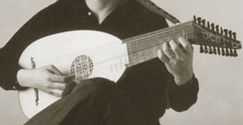
During the early days of the early music movement, many lutes were constructed by available luthiers, whose specialty was often classical guitars. Such lutes were heavily built with construction similar to classical guitars, with fan bracing, heavy tops, fixed frets, and lined sides, all of which are anachronistic to historical lutes. As lutherie scholarship increased, makers began constructing instruments based on historical models, which have proven lighter and more responsive instruments.
Lutes built at present are invariably replicas or near copies of those surviving historical instruments that are in museums or private collections. Many are custom-built, but there is a growing number of luthiers who build lutes for general sale, and there is a fairly strong, if small, second-hand market. Due to this fairly limited market, lutes are generally more expensive than mass-produced modern instruments: factory-made guitars and violins, for example, can be purchased more cheaply than low-end lutes, but at the highest level of modern instruments, guitars and violins tend to command higher prices than lutes.
Unlike in the past there are many types of lutes encountered today: 5-course medieval lutes, renaissance lutes of 6 to 10 courses in many pitches for solo and ensemble performance of Renaissance works, the archlute of Baroque works, 11-course lutes in d-minor tuning for 17th-century French, German and Czech music, 13/14-course d-minor tuned German Baroque Lutes for later High Baroque and Classical music, theorbo for basso continuo parts in Baroque ensembles, gallichons/mandoras, bandoras, orpharions and others.
Lutenistic practice has reached considerable heights in recent years, thanks to a growing number of world-class lutenists: Rolf Lislevand, Hopkinson Smith, Paul O'Dette, Miguel Serdoura, Andreas Martin, Robert Barto, Eduardo Egüez, Edin Karamazov, Nigel North, Christopher Wilson, Luca Pianca, Ben Salfield, Yasunori Imamura, Anthony Bailes, Peter Croton, Xavier Diaz-Latorre. Singer-songwriter Sting has also played lute and archlute, in and out of his collaborations with Edin Karamazov, and Jan Akkerman released two albums of lute music in the 1970s while he was a guitarist in the Dutch rock band Focus. Lutenist/Composer Jozef van Wissem composed the soundtrack to the Jim Jarmusch film Only Lovers Left Alive.
Lutes of several regional types are also common in Greece: laouto, and outi.
Images for kids
-
Orazio Gentileschi's young lutenist, painted c. 1626, plays a 10-course lute, typical of the time from around 1600 through the 1630s
See also
 In Spanish: Laúd para niños
In Spanish: Laúd para niños


